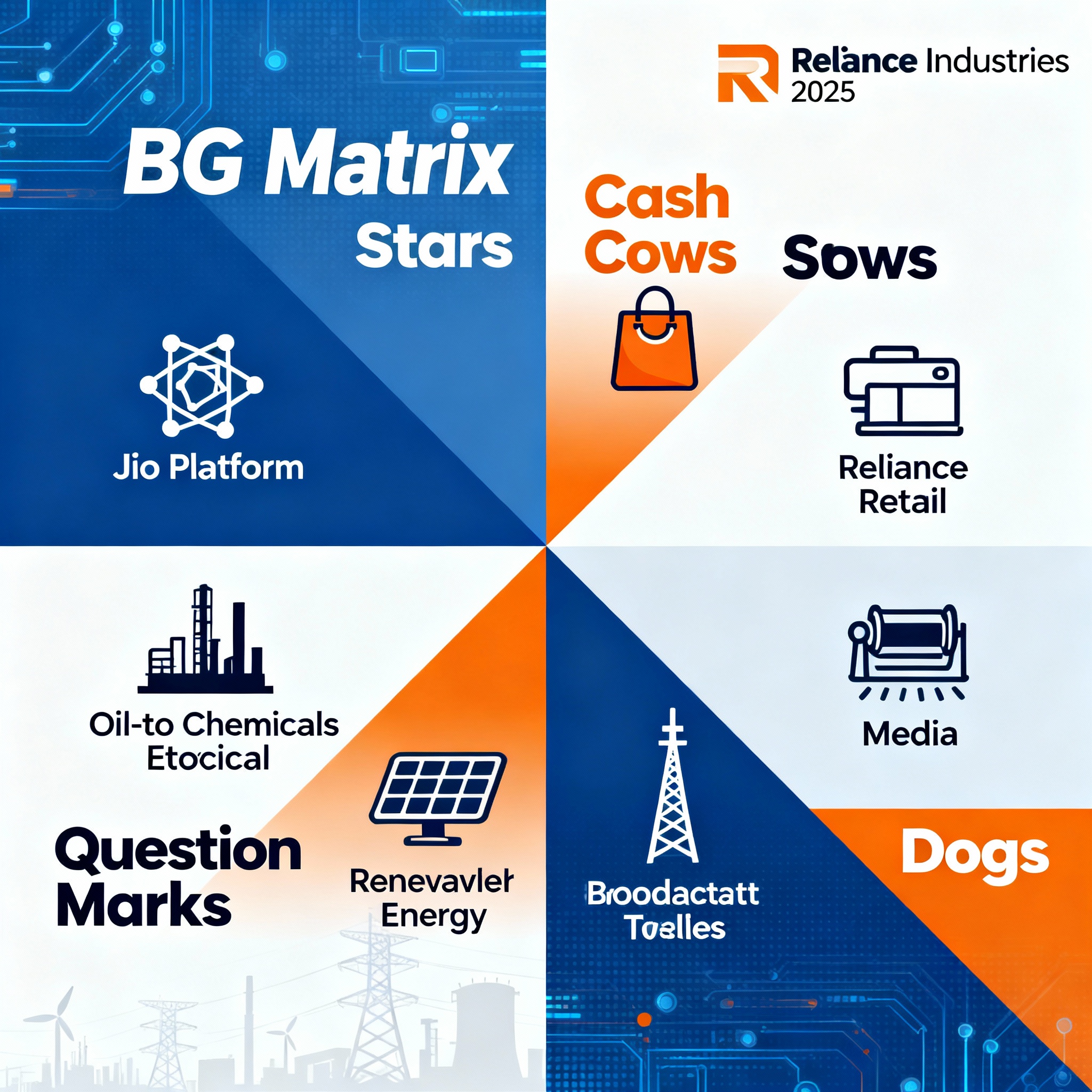Summary
The BCG Matrix of Reliance Industries is a strategic framework that helps analyze the diversified portfolio of one of India’s largest conglomerates. Reliance Industries Limited (RIL), led by Mukesh Ambani, operates across multiple sectors—energy, petrochemicals, retail, digital services, telecom, and new energy. Through this BCG analysis, we can identify which businesses are driving growth, which generate consistent profits, and which may require restructuring or strategic divestment.
This blog provides a detailed exploration of each quadrant—Stars, Cash Cows, Question Marks, and Dogs—and explains how Reliance allocates resources and manages risks to maintain leadership and expand globally.
Reliance Industries Limited (RIL) stands as one of India’s most powerful and diversified business conglomerates. From oil refining to digital technology, Reliance has mastered the art of balancing legacy businesses with future-ready innovations. The BCG Matrix of Reliance Industries serves as a strategic tool to assess its diverse business portfolio and understand how each segment contributes to its overall performance.
In today’s rapidly evolving economic landscape, companies like Reliance must continuously analyze their business units to ensure sustainable growth. The Reliance Industries BCG analysis helps identify which segments to invest in, sustain, or optimize, aligning perfectly with the company’s vision to become a global leader in sustainable and digital growth.
About Reliance Industries Limited
Company Overview
Founded in 1966 by Dhirubhai Ambani, Reliance Industries Limited (RIL) is headquartered in Mumbai, India. Today, it is one of the world’s largest conglomerates, with interests spanning energy, petrochemicals, telecommunications, retail, and renewable energy.
Reliance is currently India’s most valuable company by market capitalization, employing over 3,90,000 people and generating revenues exceeding ₹9 lakh crore (FY 2024–25).
The company’s core mission focuses on driving India’s transition toward digital empowerment and clean energy while maintaining leadership in its traditional businesses.
Business Segments of Reliance Industries
Reliance operates through a diversified set of verticals:
- Petrochemicals and Refining (Traditional Core Business)
- Jio Platforms (Telecom and Digital Services)
- Reliance Retail (Consumer and Lifestyle Segment)
- Renewable Energy & Green Hydrogen (Emerging Business)
- Media & Entertainment (Viacom18, Network18)
Each of these verticals operates with distinct growth rates and profitability levels, making the BCG Matrix an essential analytical tool for portfolio management.
Financial Overview (2025 Snapshot)
- Revenue (FY 2024–25): ₹9.2 lakh crore
- Net Profit: ₹81,000 crore
- Key Contributors:
- O2C (Oil-to-Chemicals): 45%
- Retail: 25%
- Digital (Jio Platforms): 20%
- New Energy and Others: 10%
The data highlights how Reliance is gradually shifting from a fossil-fuel-dependent business to a consumer and technology-driven organization.
What is the BCG Matrix

The Boston Consulting Group (BCG) Matrix is a strategic model that helps businesses categorize their products or divisions based on:
- Market Growth Rate (vertical axis)
- Relative Market Share (horizontal axis)
It divides business units into four quadrants:
- Stars: High market growth, high market share
- Cash Cows: Low market growth, high market share
- Question Marks: High market growth, low market share
- Dogs: Low market growth, low market share
This model helps companies like Reliance allocate resources efficiently, prioritize investments, and identify underperforming sectors.
Why Use the BCG Matrix for Reliance Industries?
Reliance Industries has one of the most diversified business portfolios in India. The BCG Matrix helps in:
- Understanding which sectors are driving profitability.
- Identifying high-growth opportunities in new markets.
- Maintaining balance between legacy businesses and future ventures.
- Supporting long-term strategic decision-making and capital allocation.
Benefits of Applying the BCG Matrix to Reliance Industries
Strategic Resource Allocation
The BCG Matrix of Reliance Industries enables management to invest wisely in high-potential businesses like Renewable Energy and Jio Platforms while leveraging profits from Cash Cow units like Petrochemicals.
Balanced Portfolio Management
Reliance has an exceptionally balanced business portfolio. The Reliance Industries BCG analysis helps maintain equilibrium between stable revenue generators (like O2C and Retail) and high-growth innovators (like Jio and Renewables).
Risk Diversification
By operating across diverse industries, Reliance minimizes risks associated with market volatility in any one segment. The BCG Matrix supports this diversification strategy by identifying potential vulnerabilities.
Long-Term Sustainability
Reliance’s continuous evolution—from oil refining to digital leadership and renewable energy—illustrates how strategic use of the BCG Matrix supports sustainability and future-readiness.
Detailed BCG Matrix Analysis of Reliance Industries
Stars (High Market Share, High Market Growth)

These businesses dominate high-growth markets and generate significant revenue.
Jio Platforms (Digital & Telecom)
- Overview: Jio has revolutionized India’s telecom sector with affordable internet and digital services.
- Market Position: India’s largest telecom operator with over 470 million subscribers.
- Growth Factors: Expansion into 5G, AI-driven solutions, and digital ecosystems (JioTV, JioCinema, JioMart).
- Future Outlook: Continued dominance due to digital integration and affordable pricing.
Reliance Retail
- Overview: One of India’s fastest-growing retail networks, operating more than 18,000 stores across formats—grocery, fashion, electronics, and pharma.
- Market Position: Leader in organized retail with a market share exceeding 35%.
- Growth Drivers: Omni-channel expansion, acquisitions (Zivame, Urban Ladder), and partnerships with global brands.
- Future Outlook: Retail is expected to remain a Star, given India’s booming consumer market.
Conclusion: Both Jio and Retail are strategic Stars for Reliance—highly profitable, rapidly expanding, and aligned with India’s digital and consumption-driven economy.
Cash Cows (High Market Share, Low Market Growth)
Cash Cows generate consistent revenue but operate in mature markets.
Also Read: BCG Matrix Analysis of Nike
Oil-to-Chemicals (O2C) Business
- Overview: Reliance’s traditional backbone, encompassing refining, petrochemicals, and fuel retailing.
- Market Position: One of the world’s largest refining complexes in Jamnagar with a refining capacity of 1.24 million barrels per day.
- Growth Factors: Although global oil demand has plateaued, Reliance’s cost efficiency ensures continued profitability.
- Contribution: Approximately 45% of total revenue in FY 2025.
- Outlook: Profits from this segment fund investments in newer, high-growth sectors like green energy.
Conclusion: The O2C division remains Reliance’s Cash Cow—stable, profitable, and essential for financial strength.
Question Marks (Low Market Share, High Market Growth)
These sectors have strong potential but currently limited market share.
Renewable Energy and Green Hydrogen
- Overview: Reliance has announced over $10 billion investment in renewable energy under its “Reliance New Energy” initiative.
- Growth Drivers: Solar panel manufacturing, hydrogen fuel, and battery storage solutions.
- Current Status: Emerging segment with heavy capital investment but limited short-term returns.
- Outlook: With global energy transition accelerating, this segment could become Reliance’s next “Star” in the coming decade.
Media & Entertainment (Viacom18 & Network18)
- Overview: Reliance owns stakes in Viacom18, which operates major networks like Colors TV and JioCinema.
- Growth Potential: Rapid rise of OTT and streaming platforms, especially after JioCinema’s IPL streaming success.
- Current Position: Moderate market share compared to global players like Disney+ Hotstar and Netflix.
- Outlook: Continued investment in digital media could shift this division into the Star quadrant.
Dogs (Low Market Share, Low Market Growth)
These segments show limited growth and contribute marginally to profit.
Textiles and Legacy Businesses
- Overview: The original textile business (“Vimal”) that started Reliance’s journey now contributes minimally to overall revenue.
- Growth Potential: Limited, due to intense competition and low profitability.
- Strategy: Reliance maintains legacy operations for brand heritage rather than profit maximization.
Conclusion: These divisions are likely to remain low-priority, with limited investment focus.
BCG Matrix Diagram of Reliance Industries
| Quadrant | Business Segment | Market Growth | Market Share | Strategic Focus |
| Stars | Jio Platforms, Reliance Retail | High | High | Invest and Expand |
| Cash Cows | Oil-to-Chemicals (O2C) | Low | High | Maintain and Harvest |
| Question Marks | Renewable Energy, Media & Entertainment | High | Low | Selective Investment |
| Dogs | Textiles & Legacy Businesses | Low | Low | Divest or Maintain Minimal Focus |
Strategic Insights from the BCG Matrix of Reliance Industries
- Diversified Leadership: Reliance manages both traditional and futuristic businesses effectively.
- Investment in Innovation: Heavy focus on green energy and digital transformation ensures long-term growth.
- Cross-Sector Synergy: Jio’s digital backbone enhances Retail and Media performance through integration.
- Financial Balance: Cash Cow segments like O2C fund the high-investment Stars and Question Marks.
- Future Sustainability: Reliance’s transition from fossil fuels to clean energy highlights a forward-looking growth strategy.
7. Challenges and Limitations of the BCG Matrix for Reliance Industries
While insightful, the BCG Matrix has certain limitations when applied to a conglomerate like Reliance:
- Interconnected Divisions: Reliance’s businesses are interlinked, making it hard to isolate performance metrics.
- Dynamic Market Conditions: Energy prices, digital disruption, and regulatory shifts impact multiple segments simultaneously.
- Qualitative Factors Ignored: The BCG Matrix focuses on quantitative aspects (growth and share), not brand equity or innovation potential.
- Capital Intensity: High investment requirements in new sectors can distort short-term profitability measures.
Conclusion
The BCG Matrix of Reliance Industries clearly showcases how the conglomerate has evolved from a petrochemical powerhouse to a diversified global player in retail, telecom, and renewable energy.
- Stars: Jio Platforms and Reliance Retail are the engines of future growth.
- Cash Cows: The O2C business ensures financial stability and consistent cash flow.
- Question Marks: Renewable Energy and Media have immense potential to become future Stars.
- Dogs: Legacy textile divisions continue for heritage rather than growth.
This balanced structure enables Reliance to sustain profitability while pursuing innovation and sustainability. The Reliance Industries BCG analysis reveals a company strategically positioned to dominate India’s energy, digital, and retail landscape in the years ahead.
FAQs
Q1. What is the BCG Matrix of Reliance Industries?
The BCG Matrix of Reliance Industries categorizes its business units based on market growth and market share to guide resource allocation and investment priorities.
Q2. Which are the Star businesses of Reliance Industries?
Jio Platforms and Reliance Retail are the Star businesses, with high market growth and dominant market share.
Q3. What is the Cash Cow of Reliance Industries?
The Oil-to-Chemicals (O2C) segment is the Cash Cow, generating stable profits that fund Reliance’s new ventures.
Q4. Which divisions are in the Question Mark category?
Renewable Energy and Media divisions fall under Question Marks, showing growth potential but lower market share.
Q5. What are the strategic insights from the Reliance Industries BCG analysis?
It highlights Reliance’s ability to maintain financial stability while investing aggressively in digital and clean energy transformation.
A digital marketer with a strong focus on SEO, content creation, and AI tools. Creates helpful, easy-to-understand content that connects with readers and ranks well on search engines. Loves using smart tools to save time, improve content quality, and grow online reach.

